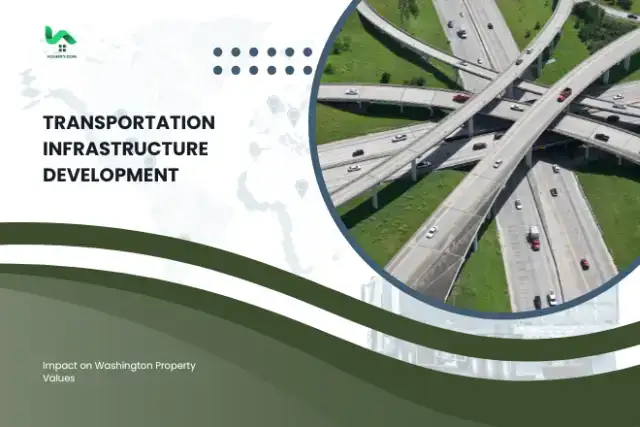Transportation Infrastructure Development Impact on Washington Property Values
How Transportation Projects Are Shaping Washington’s Real Estate Market
Transportation infrastructure is a cornerstone of economic growth and urban development. In Washington State, recent investments in highways, rail systems, and public transit are not only improving connectivity but also driving significant changes in the real estate market. With projects such as Sound Transit’s expansion, new light rail systems, and highway upgrades, the relationship between transportation development and property values has become a focal point for homeowners, investors, and policymakers.
Property values in areas benefiting from improved infrastructure often see substantial appreciation, as enhanced accessibility makes neighborhoods more desirable. Conversely, areas with outdated or congested transportation systems may experience stagnation or declining values. For buyers, sellers, and real estate investors, understanding the Transportation Infrastructure Development Impact on Washington Property Values is essential for making informed decisions.
This article delves into how Washington’s ongoing transportation projects are shaping property values across the state. From urban hubs like Seattle to smaller cities like Spokane, we’ll explore the factors influencing real estate trends, highlight key projects, and provide actionable insights for stakeholders in Washington’s real estate market.

Why People Search About Transportation’s Impact on Property Values
The connection between transportation infrastructure and property values is a topic of interest for many audiences. People searching for Transportation Infrastructure Development Impact on Washington Property Values are typically looking for insights on how transportation upgrades influence real estate trends and investment opportunities.
Key Search Questions and Needs
- What transportation projects are happening in Washington?
- How do highways, light rail, or bus systems impact property values?
- Which areas in Washington are seeing property value increases due to transportation improvements?
- How can investors capitalize on transportation-driven property value growth?
- What are the long-term effects of transportation upgrades on real estate markets?
Search Intent Behind This Topic
- Informational Intent: Users want to understand how transportation infrastructure impacts property values.
- Navigational Intent: Many are searching for specific transportation projects, such as Sound Transit’s Link Light Rail expansion.
- Transactional Intent: Real estate investors are researching areas poised for growth due to new infrastructure.
- Commercial Intent: Users are comparing Washington's real estate opportunities with other regions based on transportation improvements.
How Transportation Infrastructure Affects Property Values
The relationship between transportation infrastructure and property values is well-documented. Improved accessibility, reduced commute times, and enhanced quality of life are just a few factors that can drive property value appreciation. Below, we break down the key ways transportation impacts real estate markets in Washington.
1. Accessibility and Connectivity
- Shorter Commute Times: Properties close to transportation hubs, such as train stations, bus routes, or highway exits, are more desirable because they reduce commute times for residents.
- Improved Walkability: Transit-oriented developments (TODs) near light rail stations and bus stops often feature walkable amenities, which increase property demand.
2. Economic Development
Transportation projects often lead to new commercial developments, which in turn boost residential property values. For example:
- Sound Transit Expansion: The Link Light Rail project connecting Seattle, Bellevue, and Tacoma has spurred new mixed-use developments in neighborhoods like Northgate and Lynnwood.
- Highway Upgrades: Improvements to I-5 and I-405 have made suburban areas more accessible, increasing property values in cities like Everett and Kent.
3. Enhanced Neighborhood Appeal
Transportation upgrades can revitalize neighborhoods by improving infrastructure and attracting new residents and businesses. Examples include:
- Increased retail and dining options around transit hubs.
- The rise of eco-friendly communities near public transportation.
Major Transportation Projects in Washington and Their Impact
Washington is investing billions in transportation infrastructure. Below are some of the state’s most impactful projects and how they’re influencing property values:
1. Sound Transit 3 (ST3) Expansion
Sound Transit’s $54 billion project aims to extend light rail services across Puget Sound by 2041.
- Impact on Property Values: Homes within walking distance of light rail stations have already seen value increases of 10-15%, according to Zillow.
- Key Areas to Watch: Lynnwood, Federal Way, Redmond, and Tacoma.
2. I-405 Corridor Program
This project includes widening highways, adding express lanes, and improving public transit options along the I-405 corridor.
- Impact on Property Values: Suburban neighborhoods like Renton, Kirkland, and Bothell have become more accessible, making them attractive for families and professionals.
3. Spokane’s North Spokane Corridor (NSC)
The NSC will connect I-90 to northern Spokane, improving traffic flow and accessibility.
- Impact on Property Values: Experts predict a 5-10% increase in property values in nearby neighborhoods once the project is completed.
4. Waterfront Seattle Project
This initiative is transforming Seattle’s waterfront with new parks, bike paths, and public spaces.
- Impact on Property Values: Nearby condos and apartments have already appreciated in value due to enhanced livability.

Opportunities for Real Estate Investors
Transportation infrastructure development presents numerous investing opportunities for those looking to capitalize on rising property values. Here’s how:
1. Invest Early in Emerging Neighborhoods
- Target areas near planned transit hubs or highway upgrades, such as Northgate or Tacoma Dome.
- Properties purchased before project completion often see the greatest appreciation.
2. Focus on Transit-Oriented Developments (TODs)
- TODs are high-density developments near transit hubs, combining residential, retail, and office spaces.
- These properties attract renters and buyers seeking convenience and walkability.
3. Explore Multi-Family Properties
- Improved transportation makes multi-family housing near transit hubs more appealing to renters.
- Investors can benefit from higher occupancy rates and rental income.
Tips for Buyers and Sellers in Transportation-Driven Markets
For Buyers:
- Research current and planned transportation projects in your target area.
- Consider the long-term appreciation potential of properties near transit hubs.
For Sellers:
- Highlight proximity to transportation improvements when marketing your property.
- If possible, wait to sell until a nearby project is complete to maximize your return.
Key Takeaways: Transportation and Real Estate
The Transportation Infrastructure Development Impact on Washington Property Values underscores the profound connection between improved accessibility and rising real estate demand. From light rail expansions to highway upgrades, transportation projects are reshaping neighborhoods and boosting property values across the state.
By understanding the dynamics of these changes, buyers, sellers, and investors can position themselves for success. Whether you’re looking to purchase near a transit hub or sell in an area benefiting from infrastructure improvements, staying informed about Washington’s transportation developments is crucial.
Do you have thoughts or questions about transportation’s impact on the real estate market? Share them in the comments below! If you found this article helpful, consider sharing it on social media to help others explore the opportunities created by Washington’s transportation revolution.